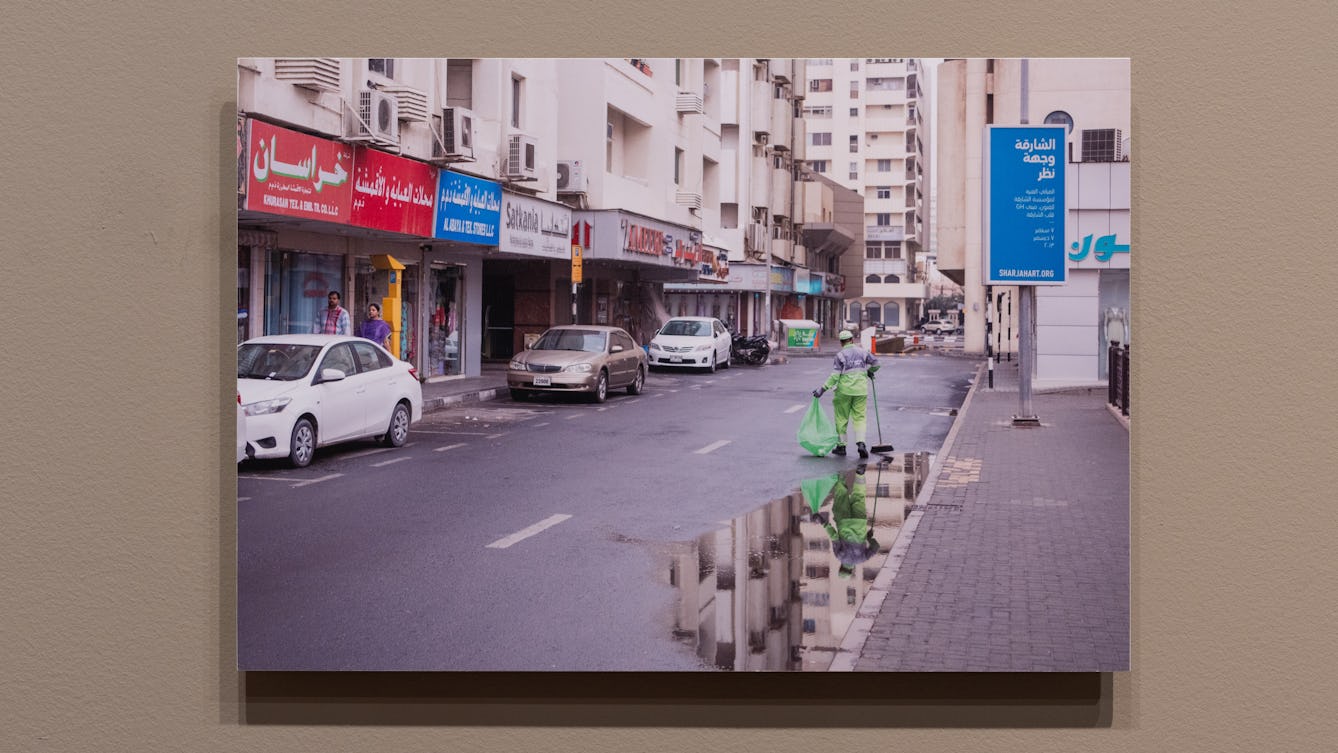Hello, my name is Vikram Divecha. I have been living and working in the United Arab Emirates for many years now. My practice often sees me negotiating with urban systems and working with the everyday processes that surround us, such as gardening, demolition and sanitation.
For this work, ‘Sweeping’, I collaborated with five workers – Assainar, Khayyum, Rafique, Altaf, and Afzal. Employed by the city authorities, their job is to keep the streets clean. Like many migrant workers, their labour, which is essential to the functioning of our cities, often remains unacknowledged.
Spread across the wall are a street map and six colour photographs, four of which will be described. The map is in the centre of the display, with three photographs on either side, spanning about 4 metres in total. The landscape-oriented prints are different sizes, and hung at different heights, to suggest movement and mapping. The photographs document the workers sweeping the streets. All are dressed in bright green uniforms: trousers and matching shirt, with reflective silver stripes around the chest and calves. They wear sturdy black boots and black gloves, leaving only their faces uncovered beneath bright green caps. Each worker carries a long-handled broom to collect refuse in a green trash bag. In the leftmost image, a worker sweeps refuse from the kerb while members of the public pass by in black abayas and a white thobe – loose fitting, full-length garments – and open-toe sandals. In the next image, a worker and the cream-coloured residential buildings around him are reflected in a puddle of rain, as he navigates a street lined with shops with brightly coloured signs with Arabic and English lettering. In the third image, a worker pauses to look down at his mobile phone.
In 2016 I spent three months walking individually with each worker. During this time, I got to know them, their work and the dynamics of the area. They worked in Al Shuweiheen, Sharjah, a busy residential neighborhood lined with shops and restaurants. Located in this area is also the Sharjah Art Museum, a high-walled building. Each worker swept alone, following a specific route through narrow streets and by-lanes, collecting refuse in green bags, circulating his designated area three to four times, from early morning until lunch. The litter was mostly paper cups, cans, bottles, wrappers, cigarettes, receipts, dust and other waste. The translucent bags were archives of the neighbourhood’s consumption habits.
All of these workers were from India, part of a large South Asian workforce. Most lived away from their families. We all spoke a common language - Hindi – and exchanged a lot about our lives during our walks and when we all gathered at a cafeteria. I was made aware of a map on which their routes were plotted. After many discussions, one fine morning around the cafeteria table the workers and myself replotted their routes on the map so they all ended outside the museum’s entrance. This turned into a daily performance. After each worker finished a cycle, he would deposit a bag of refuse on the sidewalk in front of the museum. A row of about 25 green bags would accumulate until 2 pm, before being cleared by the garbage truck. The photograph at the far right of the display shows the bags nestled together between the museum’s high, cream-coloured exterior wall and the street. This line of green trash bags was re-inscribed every day for a few months.
Near the centre of the display is the map showing the workers’ replotted routes. The black-and-white printed map depicts rows of buildings intersected by straight roads, and bordered by large main roads. The buildings are represented by simple squares and rectangles. “08 Al Shuheen Sector-1” is printed across the bottom right of the map. Five hand-drawn lines in different colours trace the routes around the streets in the top half of the map. A red line circles six blocks down the left side of the map; a blue line encompasses a large semi-rectangular-shaped plaza that horizontally spans the map’s top-left corner; a green line weaves around tightly clustered blocks in the top-right corner; a pink line follows a row of units in the centre; and below these, a yellow line loops around terraced buildings. Arrows along the lines indicate the direction of the routes, which meet in a huddle of coloured dots outside the museum, a long horizontal oblong beneath the plaza in the top centre of the map.
‘Sweeping’ draws attention to what we overlook. In presenting trash, the workers claimed their labour as a creation of beauty. Waste also became a mediator, initiating encounters between the neighbourhood, the museum, and the workers. Till today, Afzal recounts the museum staff pushing the trash bags away from the entrance. But we would bring them back. Pedestrians paused and enquired. Shopkeepers spun their own theories. Some stories were recounted to me. Some stories, perhaps, still reside in the neighbourhood.
This is the end of stop 8.
